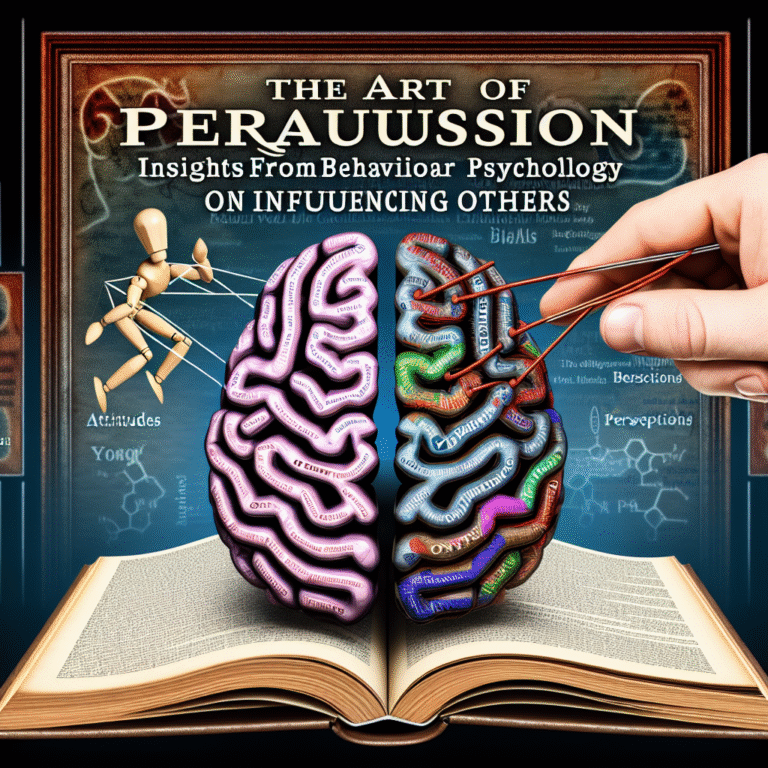Habits by Design: How Behavioral Psychology Informs Effective Habit Change
Introduction
Have you ever tried to instill a new habit in your life, only to find yourself falling back into old routines? If so, you’re not alone. The human experience is often a battle of will against ingrained behaviors. Understanding how habits form and how they can be modified is crucial, not only for personal growth but also for enhancing productivity and fostering healthier lifestyles. In this article, we will delve into the fascinating interplay between habits by design and behavioral psychology, unraveling the profound insights that can help us enact effective habit change.
The Science Behind Habits
The Habit Loop: Cue, Routine, Reward
To grasp how behavioral psychology can guide us in changing our habits, we first need to understand the fundamental mechanism of habit formation: the habit loop, which consists of three components: cue, routine, and reward.
- Cue: This is the trigger that initiates the habit. It can be anything from time of day, emotional state, or physical location.
- Routine: This is the behavior that follows the cue. It’s often automatic and requires little conscious thought.
- Reward: This concludes the habit loop and reinforces the routine. It’s the positive feedback that encourages the brain to continue the cycle.

Case Study: The Power of Cues
A classic example of these elements in action can be observed in the story of Charles Duhigg’s analysis of a man named Eugene Pauly, who, after developing Alzheimer’s disease, could not form new memories but maintained the ability to perform certain habits. His habitual routines were triggered by environmental cues, demonstrating that even without conscious awareness, habits remain deeply rooted.
Analysis: This case illustrates the power of environmental cues and how they can serve as a foundation for designing effective habit change.
Designing Effective Habits
Create an Environment for Success
Understanding the mechanics of the habit loop allows us to manipulate it to create new habits. A study conducted by researchers at Stanford University highlighted how altering one’s environment can significantly increase the likelihood of adopting new habits. For instance, placing healthy snacks at eye level in your kitchen can prompt better nutritional choices.
Actionable Insight: Identify the cues in your environment that lead to unhealthy habits and consider how you can redesign your space to support positive change.
Implementing Small Changes
Behavioral psychology endorses the idea of “small wins.” By breaking down a larger goal into manageable tasks, you reduce the psychological burden associated with change. This strategy can catalyze a mindset shift and sustain motivation.
Case Study: In a controlled study on workplace habits, employees were encouraged to take short walking breaks instead of sitting for extended periods. Initially, the goal was to increase physical activity by only 10 minutes a day. Over time, participants increased their walking habits, demonstrating the cumulative power of small changes.
Analysis: This study showcases how modest increments can lead to significant shifts in behavior over time.
Incorporating the 21/90 Rule
Another effective strategy for habit formation is the 21/90 rule, which suggests that it takes 21 days to form a habit and 90 days to make it a permanent lifestyle change. While the science behind the 21-day timeframe is debated, it serves as a helpful guideline for those looking to create lasting changes.
Actionable Insight: Set a goal to commit to a new habit for at least 21 days, reassess your progress, and then continue this commitment for an additional 90 days to solidify it into your routine.
The Role of Motivation and Accountability
Finding Your Why
Understanding your underlying motivations is essential when it comes to effective habit change. Behavioral psychology suggests that habits are more likely to stick when tied to a deeper personal value or goal.
Case Study: Jennifer, a corporate employee, wanted to cultivate a daily exercise habit. By identifying her reason—improving her energy levels to be more present with her children—she found motivation that transcended surface-level desires for fitness.
Analysis: This case underscores the importance of introspection in habit formation and the need to connect habits to meaningful personal values.
The Impact of Accountability
Accountability can serve as a potent motivator for habit development. Research in behavioral psychology has found that sharing your goals with others—be it friends, family, or colleagues—can increase the likelihood of success.
Example (Table 1): The Role of Accountability in Habit Change
| Method of Accountability | Success Rate (%) |
|---|---|
| Self-monitoring | 35 |
| Peer support | 60 |
| Public commitment | 80 |
Case Study: The Accountability Partnership
A popular example of achieving goals through accountability comes from a seminar where participants paired up and committed to weekly check-ins about their exercise routines. The results demonstrated a significant increase in adherence rates among those who reported to a partner.
Analysis: The effectiveness of accountability emphasizes the social nature of habit formation, aligning with principles of behavioral psychology.
Tools and Techniques for Effective Habit Change
Habit Tracking
With the rise of technology, habit tracking applications have transformed how individuals approach habit change. These tools can provide valuable insights by tracking progress over time.
Incorporating a habit tracker into your routine can help maintain focus and promote consistency.
Gamification
Gamification is the use of game-like elements in non-game contexts. It can be a fun way to encourage habit formation, making the process feel less like a chore and more like a challenge.
Case Study: The Habitica App
Habitica gamifies habit formation by transforming everyday tasks into a role-playing game. Users earn rewards and level up by completing their habits. A significant number of users reported enjoying the process and becoming more consistent as a result.
Analysis: This illustrates how behavioral psychology principles can be adapted into engaging platforms for behavior change.
Conclusion
Through our exploration of habits by design and how behavioral psychology informs effective habit change, it becomes clear that understanding human behavior is key to transforming our routines. By utilizing the habit loop, enhancing our environments, establishing accountability, and implementing gradual changes, we can design a pathway toward lasting personal transformation.
Remember, every small step is a step forward. Embrace the journey of habit change with the insight that meaningful transformation is possible—one habit at a time.
FAQs
1. How long does it take to change a habit?
While the “21 days” concept is widely circulated, research indicates that the timeline varies for each individual. Many studies suggest that it could take an average of 66 days to establish a new habit.
2. What if I fail to maintain my new habit?
Failure is often part of the process of change. Instead of viewing it as a setback, see it as a learning opportunity. Assess what didn’t work and adjust your strategy.
3. Can I change multiple habits at once?
Changing multiple habits simultaneously can be overwhelming. Behavioral psychologists recommend focusing on one habit at a time to increase the chances of success.
4. What role does self-discipline play in habit change?
While self-discipline is important, understanding and designing your environment can significantly ease the effort required to maintain new habits.
5. How do I stay motivated during the habit change process?
Remind yourself of your “why,” track your progress, and consider sharing your journey with others for additional support and accountability.
In conclusion, marrying insights from behavioral psychology with practical frameworks can pave the way for transformative habit changes. By designing our habits with intention, we become architects of our lives, capable of cultivating the change we wish to see.














